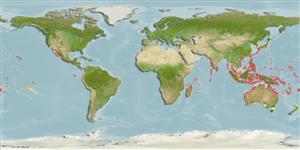>
Centrarchiformes (Basses) >
Kuhliidae (Aholeholes)
Etymology: Kuhlia: Because of Heindrich Kuhl, 1797-1821; researcher also with lizards (Gekkonidae).
Eponymy: Dr Heinrich Kuhl (1797–1821) was a German naturalist and zoologist. [...] (Ref. 128868), visit book page.
More on author: Lacepède.
Environment: milieu / climate zone / depth range / distribution range
Ecologia
marinhas; Água doce; estuarina associadas(os) a recifes; catádromo (Ref. 51243); intervalo de profundidade 0 - 5 m (Ref. 86942). Tropical; 20°C - 26°C (Ref. 2060)
Africa to Asia and Oceania: East Africa to Samoa, north to the Ryukyu Islands, south to Queensland, Australia and New Caledonia.
Comprimento de primeira maturação / Tamanho / Peso / Idade
Maturity: Lm 26.5, range 26 - 27 cm
Max length : 45.0 cm TL macho/indeterminado; (Ref. 5329); common length : 25.0 cm SL macho/indeterminado; (Ref. 2847); peso máx. publicado: 2.7 kg (Ref. 5329)
Espinhos dorsais (total) : 10; Raios dorsais (total) : 10 - 12; Espinhos anais: 3; Raios anais : 9 - 11. Diagnosis: Preorbital serrae 10-15 (obsolete in large specimens); body depth 2.6-3.0 in SL; mouth large for genus, maxilla reaching to below posterior half of eye; caudal fin emarginate, lobes somewhat rounded, caudal concavity 5.3-8.7 in head length (Ref. 41640). Reduced number of lateral line scales; 17-18(19) gillrakers on lower part of first bracnhial arch; body with spots (Ref. 79840).
Coloration: Silvery, the scales dorsally on body with black edges, those on side with a black bar or spot; juveniles with a broad black zone, edged above and below in white, in soft portion of dorsal fin, and each lobe of caudal fin with a large, white-edged black spot; black areas in these fins enlarge with growth until in adults most of these fins black (caudal with upper and lower edges and corners whitish) (Ref. 41640).
Primarily a freshwater inhabitant but may penetrate adjacent marine habitats (Ref. 41640). Adults occur in estuaries and the middle reaches of rivers; usually in relatively fast-flowing, clear streams (Ref. 2847, 79840). Usually in rainforests, as well as in rocky pools below waterfalls (Ref. 44894). Adults are omnivorous, feeding on small fishes, insects, crustaceans and fruits (figs) that drop into the water. Specific breeding habits are unknown, but adults move downstream into estuaries or to the sea to spawn (Ref. 44894). Neither anterolateral groove nor venom gland is present (Ref. 57406). Good food fish (Ref. 5329).
Ciclo de vida ou comportamento de acasalamento
Maturidade | Reprodução | Desova | Ovos | Fecundidade | Larvas
Presumably non-guarders (RF).
Randall, J.E. and H.A. Randall, 2001. Review of the fishes of the genus Kuhlia (Perciformes: Kuhliidae) of the Central Pacific. Pac. Sci. 55(3):227-256. (Ref. 41640)
Status na Lista Vermelha da UICN (Ref. 130435: Version 2024-1)
Ameaça para os humanos
Harmless
Uso pelos humanos
Pescarias: espécies comerciais; peixe esportivo: sim
Ferramentas
Relatórios especiais
Baixar XML
Fontes da internet
Estimates based on models
Preferred temperature (Ref.
123201): 24.2 - 29.3, mean 28.4 °C (based on 2775 cells).
Índice de diversidade filogenética (Ref.
82804): PD
50 = 0.5002 [Uniqueness, from 0.5 = low to 2.0 = high].
Bayesian length-weight: a=0.01413 (0.00597 - 0.03345), b=3.06 (2.85 - 3.27), in cm total length, based on LWR estimates for this (Sub)family-body shape (Ref.
93245).
Nível Trófico (Ref.
69278): 3.2 ±0.45 se; based on food items.
Resiliência (Ref.
120179): médio(a), tempo mínimo de duplicação da população 1,4 - 4,4 anos (Preliminary K or Fecundity.).
Fishing Vulnerability (Ref.
59153): Low to moderate vulnerability (35 of 100).
Nutrients (Ref.
124155): Calcium = 47.5 [26.2, 74.1] mg/100g; Iron = 0.537 [0.323, 0.863] mg/100g; Protein = 19.4 [18.3, 20.4] %; Omega3 = 0.111 [0.070, 0.175] g/100g; Selenium = 19.4 [11.2, 34.6] μg/100g; VitaminA = 80.8 [27.4, 245.9] μg/100g; Zinc = 1.58 [1.13, 2.15] mg/100g (wet weight);
